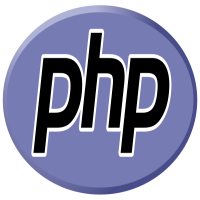
PHP Introduction
PHP is the most popular server-side scripting language for creating dynamic web pages.
PHP stands for Hypertext Preprocessor. PHP is a very popular and widely-used open source server-side scripting language to write dynamically generated web pages. PHP was originally created by Rasmus Lerdorf in 1994. It was initially known as Personal Home Page.
PHP scripts are executed on the server and the result is sent to the web browser as plain HTML. PHP can be integrated with the number of popular databases, including MySQL, PostgreSQL, Oracle, Microsoft SQL Server, Sybase, and so on. The current major version of PHP is 8. All of the code in this tutorial has been tested and validated against the most recent release of PHP 8.
PHP is very powerful language yet easy to learn and use. So bookmark this website and continued on.
1 - What You Can Do with PHP
There are lot more things you can do with PHP.
- You can generate pages and files dynamically.
- You can create, open, read, write and close files on the server.
- You can collect data from a web form such as user information, email, phone no, etc.
- You can send emails to the users of your website.
- You can send and receive cookies to track the visitor of your website.
- You can store, delete, and modify information in your database.
- You can restrict unauthorized access to your website.
- You can encrypt data for safe transmission over internet.
The list does not end here, there are many other interesting things that you can do with PHP. You will learn about all of them in detail in upcoming chapters.
2 - Advantages of PHP over Other Languages
If you're familiar with other server-side languages like ASP.NET or Java, you might be wondering what makes PHP so special. There are several advantages why one should choose PHP.
- Easy to learn: PHP is easy to learn and use. For beginner programmers who just started out in web development, PHP is often considered as the preferable choice of language to learn.
- Open source: PHP is an open-source project. It is developed and maintained by a worldwide community of developers who make its source code freely available to download and use.
- Portability: PHP runs on various platforms such as Microsoft Windows, Linux, Mac OS, etc. and it is compatible with almost all servers used today such Apache, IIS, etc.
- Fast Performance: Scripts written in PHP usually execute or runs faster than those written in other scripting languages like ASP, Ruby, Python, Java, etc.
- Vast Community: Since PHP is supported by the worldwide community, finding help or documentation related to PHP online is extremely easy.
3 - What This Tutorial Covers
This PHP tutorial series covers all the fundamental programming concepts, including data types, operators, creating and using variables, generating outputs, structuring your code to make decisions in your programs or to loop over the same block of code multiple times, creating and manipulating strings and arrays, defining and calling functions, and so on.
Once you're comfortable with the basics, you'll move on to next level that explains the concept file system, sessions and cookies, dates and times, as well as how to send email from your script, handling and validating forms, perform data filtration and handling errors in PHP.
Finally, you'll explore some advanced concepts like classes and objects, parsing JSON data, pattern matching with regular expressions, exception handling as well as how to use PHP to manipulate data in MySQL database and create useful features like user login system, Ajax search, etc.